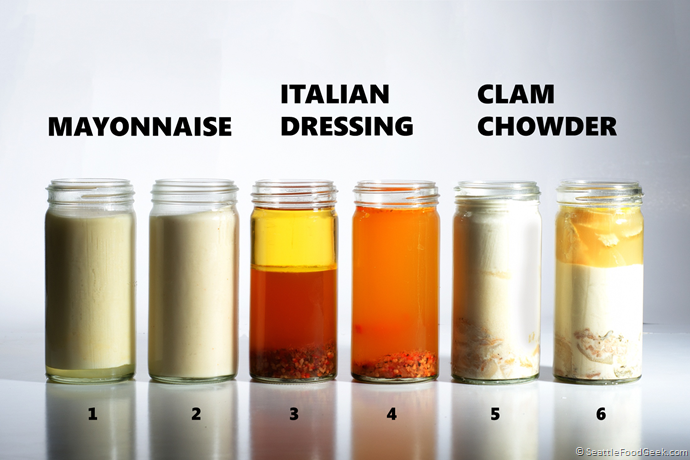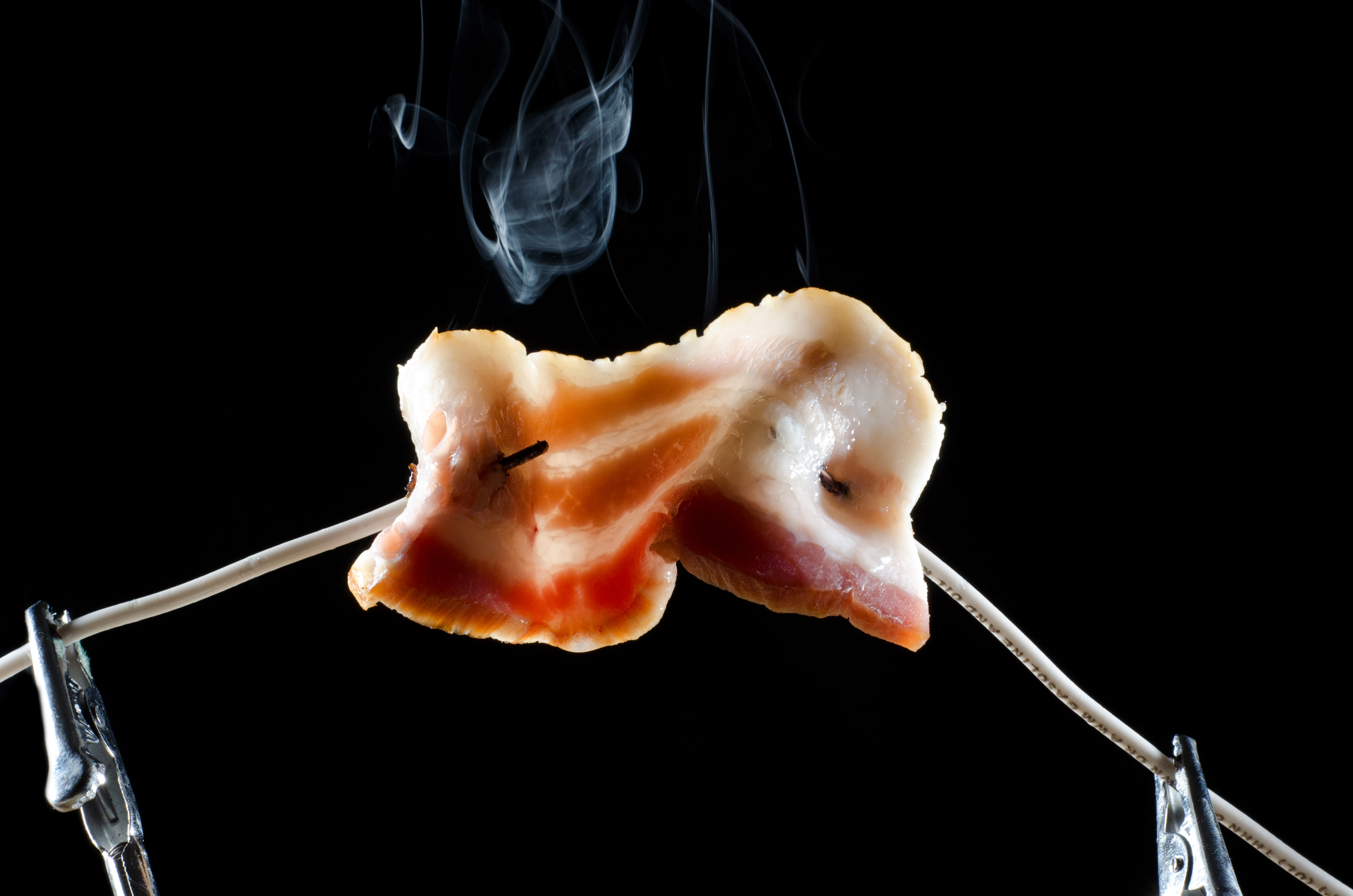
Have you ever wondered what happens when you subject shelf-stable emulsions from your local grocery store to 3,000 times the force of Earth’s gravity using a centrifuge? Yeah, me too!
I chose three different types of emulsions: mayonnaise, salad dressing, and canned soup. [I also tested spaghetti sauce, but one of the test vials exploded mid-‘fuge, so the results were inconclusive]. For each emulsion, I centrifuged two popular brands to note their differences in separation after an hour at 3,000 RPMs (equivalent to 3,000 Gs in my centrifuge). It is important to note that an emulsion that separates under these conditions does not indicate a better or worse product, simply a stronger or weaker emulsion. The goal of this experiment was not to determine which brand you should buy. The goal of this experiment was to spin a bunch of shit at extremely high G-forces and see what happened.
The results:
- Best Foods Real Mayonnaise – Mayonnaise, as it turns out, is a pretty strong emulsion. This brand showed a slight separation visible at the bottom of the vial, but more or less held together. If I spun it for longer, I wonder if I would have ended up with a layer of egg and a layer of oil…
- Miracle Whip – This was the strongest emulsion I tested, showing no signs of separation whatsoever. I personally can’t stand the stuff, but for those of you who are fans of this mayo alternative, rest assured that it is highly acceleration-resistant.
- Kroger Zesty Italian Dressing – If you’ve ever made an oil and vinegar salad dressing at home, you know it’s naturally prone to separation. This brand separated easily leaving perfectly clear oil at the top, vinegar in the middle and solids at the bottom. +1 for “just like mom makes”, especially if your mom makes it from a bottle.
- Kraft Free Zesty Italian Dressing – I chose this product because, on the shelf, the emulsion looked extremely stable – all of the solids were held in suspension, which was likely for marketing reasons. Although all of the solids separated out, the liquid phase didn’t clarify at all. It seems the people at Kraft have found a way to make oil, water and vinegar extremely fond of one another.
- Kroger Chunky New England Style Clam Chowder – I expected that the chunky solids would wind up compressed at the bottom of the vial, but I was surprised to discover that the soupy part of the soup held intact. I guess Chef Kroger (cough, cough) must have been very careful with his roux when he made this particular can of soup.
- Campbell’s Select Harvest 98% Fat Free New England Clam Chowder – As you can see, there was some significant separation in this sample. My guess is the light-colored top layer of thin, watery liquid has something to do with the low fat claims on the label – diluting soup with water would certainly be an easier way to make it “healthier”.
As I said earlier, this experiment was more about messing around than testing a hypothesis. Speaking of messing around, what substances would you like me to try spinning? The centrifuge is still my newest toy, and like all toys, I’m eager to fill it with unusual liquids.

Sriracha, Hoisin, Salsa, Cream of _____ soup, Prepared Horseradish, Ketchup, Mustard, Relish … not necessarily in that order 🙂
Scott,
Can you share with us what model centrifuge you used for this experiment?
Ross
Yoo-Hoo, even when sitting on the shelf, tends to settle into a nice multilayered sediment (three shades of brown dirt, plus liquid.) You might as well try running a bottle of Yoo-Hoo through the centrifuge ’cause it sure isn’t good for drinking.
Another idea: How ’bout Marshmallow Fluff? I predict it’ll separate into a little puddle of clear corn syrup, and a lot of air — this is what you get if it sits on the shelf six months. Other semi-solid candy products might also be separable, like the mucus inside a Cadbury Egg.
Oh, and do you think the different fats in bacon grease would separate out in layers, or would it all just turn to one layer of mixed fat and one layer of oil?
I would go through my pantry and do anything I see: olives, anchovies, barbecue sauce, etc.
Please post a photo of your centrifuge, cost,?
The oil didn’t fall out of the emulsion from the “free” dressing because it is fat (oil) free.
mine has got to be chili sauce.
I best most of the products you see at the grocery store, especially dressings, that look really emulsified use xanthan gum.
Count me in the group that would really like to know the details on what machine, rpm, etc… 🙂
The centrifuge I’m using is a Beckman TJ-6 with the optional refrigeration unit. It has a 2L capacity (when using plastic containers that fill the rotor buckets, and pulls a maximum of 1520 Gs at 3000 RPMs. With a fixed angle rotor, it can get up to 10000 RPMs.
I tracked mine down at a lab surplus shop in Seattle. This is a pretty common model on eBay, too. I’d highly recommend getting a unit with refrigeration since the temperatures inside the centrifuge can get quite warm and spoil food. It’s important to note that the units with refrigeration use a different lid than the units without. If you buy the compressor separately, you’ll also need to track down a vented lid.
How about determining the percentage fat in different cuts of meat? All you should need is a scale, blender, and the ‘fuge… oh, and meat. Lots of meat.